|

| Callsign
~ Tradewinds (already available in FS9) HERE |
|
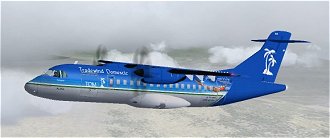
PJ-TEA 'Calypso'
FS9 ONLY
|
Aerospatiale
ATR42-500 ~ Francisco Sánchez-Castañer
The
ATR-72 is a stretched development of the popular ATR-42
and was launched in January 1986.
Significant
differences between the ATR-72 and the smaller and older
ATR-42 include a 4.50m (14ft 9in) fuselage stretch and
reworked wings. The ATR-72's wings are new outboard of
the engine nacelles and with 30% of it made up of composite
materials, comprising composite spars and skin panels
and a carbon fibre wing box.
Aside
from the baseline ATR-72-200, two developments have been
offered, the ATR-72-210, and the ATR-72-500 (previously
ATR-72-210A). The ATR-72-210 is optimised for operations
in hot and high conditions. It has more powerful PW-127
engines for better takeoff performance.
The
ATR-72-500 (renamed from ATR-72-210A on May 18, 1998)
further improved hot and high model was certificated in
early 1997. It features PW-127Fs driving six blade composite
Hamilton Sundstrand propellers.
|
|
|
Repaint by Meindert Wijnberg
Panel and full package
~ Included
|
|
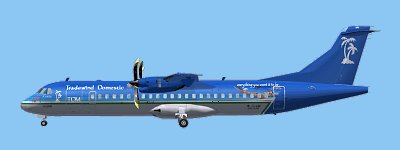
PJ-GBH
'Kralendijk'
FDE
Update
|
Aerospatiale
ATR72-500 ~ Francisco Sánchez-Castañer
The
ATR-72 is a stretched development of the popular ATR-42
and was launched in January 1986.
Significant
differences between the ATR-72 and the smaller and older
ATR-42 include a 4.50m (14ft 9in) fuselage stretch and
reworked wings. The ATR-72's wings are new outboard of
the engine nacelles and with 30% of it made up of composite
materials, comprising composite spars and skin panels
and a carbon fibre wing box.
Aside
from the baseline ATR-72-200, two developments have been
offered, the ATR-72-210, and the ATR-72-500 (previously
ATR-72-210A). The ATR-72-210 is optimised for operations
in hot and high conditions. It has more powerful PW-127
engines for better takeoff performance.
The
ATR-72-500 (renamed from ATR-72-210A on May 18, 1998)
further improved hot and high model was certificated in
early 1997. It features PW-127Fs driving six blade composite
Hamilton Sundstrand propellers.
|
|
|
Other Suggested Files:
WARNING !
This archive comes with an aircraft specific version of FSUIPC.
If you have a registered copy of FSUIP back it up first and reinstall
it after you've installed this aircraft. I included it because the
panel will not work without FSUIPC.
Alternatively install it to a dummy location and deselect that
file when moving files to FS9
|
Repaint by JF
Panel and full package
~ Included
|
|
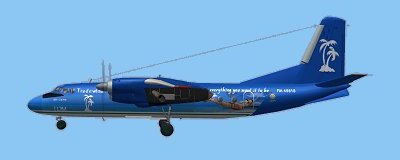
RA
46610
FS9
ONLY
Texture
ONLY
|
Antonov
An-24RV ~ SamDim Design
The
An-24 is the original aircraft in a prolific and highly
successful family of twin turboprop civil and military
transports. The
An-24 first flew in April 1960 with first production versions
entering Aeroflot service in September 1963. Aeroflot
was the largest An-24 operator, with others going to Soviet
client nations.
Subsequent
production versions of the An-24 were the An-24B and the
An-24T freighter. A small turbojet in the right engine
nacelle to boost takeoff performance resulted in the An-24RT
and An-24RV. The An-24P firebomber was also developed
before Ukrainian production ceased in 1978.
The
An-24 was also developed into the An-26 "Curl"
military tactical transport with more powerful engines
and redesigned tail, which itself evolved into the An-32
with enhancements for better hot and high performance.
Over 550 An-26s are in civil service.
The
An-30 development has been produced in limited numbers
and is used largely for aerial survey and cartography
work. This version is identifiable by its extensive nose
glazing.
The
An-32 first flew in 1976 and features much more powerful
3760kW (5042ehp) Progress engines for improved hot and
high performance. The An-32 features above wing mounted
engines to give the larger diameter props adequate ground
clearance.
China's
Xian Aircraft Manufacturing Company is now the sole production
source for the An-24 as the Y-7. The Y-7-100 incorporates
a number of modifications including a revised passenger
interior and flightdeck, and wingtip winglets. It was
developed with the technical assistance of HAECO in Hong
Kong during the 1980s.
|
|
|
Other Essential Files:
You need to have
already installed the v2.02 Base Package from: Avsim
or
have v1 updated to v2.02
|
Repaint by JF
Textures only
|
|
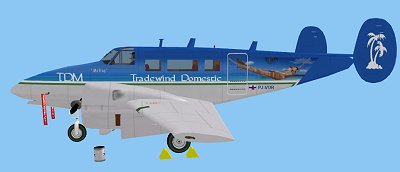
PJ-VOR
'Millie'
FS9
ONLY
|
Beechcraft
18 Volpar ~ Brian Gladden
The
Beech 18 was one of Beechcraft's most enduring designs.
In production from the late 1930's until the early 60's
many are still in use all over the world.
This
plane represents a late Model Super H with the Volpar
Trigear conversion. The Volpar kit added an extended nose
and converted the plane to a tri-gear configuration rather
than the stock taildragger landing gear.
|
|
|
Other ESSENTIAL Files:
|
Repaint by JF
|
|
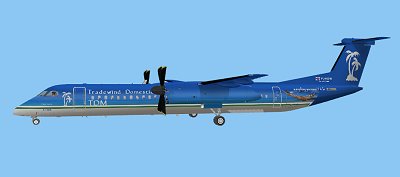
PJ-HDW
'Carriacou'
FS9
ONLY
|
Bombardier
Dash8 Q400 ~ Dreamwings
Bombardier's
70 seat de Havilland Dash 8 Series Q400 is the latest
and longest member of the successful Dash 8 twin turboprop
family, but with new engines, avionics and systems, a
modified wing and stretched fuselage is essentially an
all new aeroplane
|
|
|
Other Suggested Files:
SOUND ~ 43Mb
Dash-8
Q2-400 The Real Deal V.2
|
Repaint by JF
Panel ~ Included
|
|
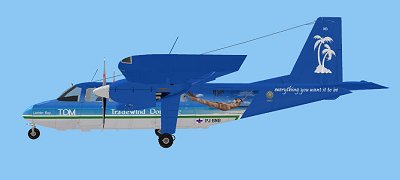
PJ-BNB
'Ladder Bay'
Textures only
FS9
ONLY
|
Britten
Norman BN2A Islander
~
Marcel Kuhnt
The
BN-2 Islander was Britten-Norman's second original design,
work on which began during 1963.
Developed
as a Dragon Rapide replacement, the emphasis was on producing
a rugged and durable aircraft that had good field performance,
low operating costs and was easy to maintain. One unusual
feature is that there is no centre aisle between seats
in the main cabin, instead there are three doors along
each side of the fuselage for passenger boarding. The
prototype BN-2 Islander was powered by two 155kW (210hp)
IO-360s and first flight was on June 13 1965.
The
first production machines were powered by 195kW (260hp)
IO-540s and were simply designated BN-2, the first flew
in 1967. A small number were built before production switched
to the BN-2A which introduced fairings to the main undercarriage
legs, wing leading edge and flap droop, and an increased
max takeoff weight. From 1970 the base A model was the
BN-2A-6 and the BN-2A-7 had extended wingtips, while the
BN-2A-2 and BN-2A-3 were powered by the 225kW (300hp)
IO-540, the latter with the extended wingtips.
Appearing
in 1972 were the 195kW (260hp) powered BN-2A-26 and extended
wingtips BN-2A-27, and the 225kW (300hp) BN-2A-20 and
extended wingtips BN-2A-21, all four models having higher
weights. Further improvements came with the BN-2B range
with higher weights, improved interior and instrument
panel and shorter diameter props. The 26, 27, 20 and 21
variants were available as before. The 27 and 21 were
later dropped while the BN-2B-20 and BN-2B-26 remain in
production. The turboprop (Allison 250) powered BN-2T
has been built since 1981.
In
September1979 Britten-Norman became Pilatus Britten-Norman,
in July 1998 it was renamed back to Britten-Norman, and
from April 2000 it became B-N Group.
|
|
|
Other ESSENTIAL Files:
DIBNA32G.zip (BN2A two
bladed prop) BN32Rest.zip and BN32Snd2.zip
from http://www.m-r-software.de/
|
Repaint by JF
|
|
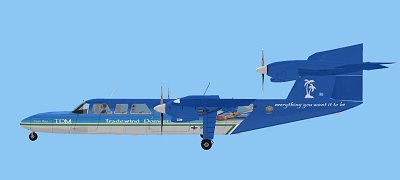
PJ-TRI
'Cove Bay'
Textures only
FS9
ONLY
|
Britten
Norman BN2A Trislander
~
Marcel Kuhnt
The
three engined Trislander takes its inspiration from the
configurations of trijets such as the L-1011 and DC-10
in its answer to the need for more power for a stretched
version of the Islander (described separately).
Britten-Norman
research showed that there existed sufficient market demand
to warrant the development of a stretched Islander, and
the company concluded that any stretched version would
need to offer a 50% increase in internal capacity. The
company's novel approach to the need for more power was
to add a third engine, rather than two engines of increased
power output. A nose mounted engine in the fashion of
the Ju-52 was considered, but due to the Islander's nose
configuration, BrittenNorman settled on mounting the engine
on the vertical tail, resulting in the BN-2A Mk.3 Trislander.
The
tail mounted engine involved significant modification
to the tail and strengthening of the rear fuselage. Other
changes over the Islander include a 2.29m (7ft 6in) fuselage
stretch forward of the wing, new main landing gear and
larger diameter wheels and tyres.
The
first Trislander was in fact converted from the second
Islander prototype, and it made the type's first flight
on September 11 1970. Early production Trislanders were
also conversions of Islanders, while subsequent Trislanders
were built on the same production line as the Islander.
The first production Trislander flew on March 6 1971,
certification was granted on May 14, and first deliveries
to a customer occurred on June 29 that year.
Britten-Norman
Trislander production ceased in 1982 after 73 were ordered
(by which stage the company had been acquired by Pilatus).
Plans to produce the Trislander in the USA as the TriCommutair
by the International Aviation Corporation, and in Australia
never came to fruition. However one of 12 kits built for
the TriCommutair project was assembled in Guernsey in
the UK and flew in March 1996.
|
|
|
Other ESSENTIAL Files:
GXTOR32G.zip, BN32Rest.zip
and BN32Snd2.zip
from http://www.m-r-software.de/
|
Repaint by JF
|
|
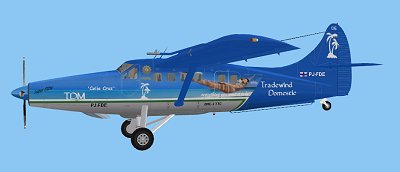
PJ-FDE
'Celia Cruz'
FS9
ONLY
|
De
Havilland DHC-3 TTC Super Otter ~ Eugene Heyart
This
airplane is the exact copy of the conversion created
by (real world) Texas Turbine Conversions. This Otter
has received a more powerfull turbine for a much better
performance.
|
|
|
Other ESSENTIAL Files:
|
Repaint by Francisco
Aguiar
|
|
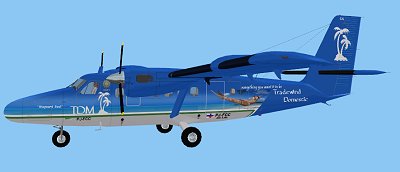
PJ-FCC
'Wayward Soul'
FS9
ONLY
|
De
Havilland DHC-6 300 ~ Premiercraft
Canada's
most successful commercial aircraft program with more
than 800 built, the Twin Otter remains popular for its
rugged construction and useful STOL performance.
The
Series 300 was introduced from the 231st production aircraft
in 1969. It featured the lengthened nose, but also introduced
more powerful engines, thus allowing a 450kg (1000lb)
increase in takeoff weight and a 20 seat interior. Production
ceased in late 1988. In addition, six 300S enhanced STOL
performance DHC-6-300s were built in the mid 1970s.
|
|
|
Other ESSENTIAL Files:
DH6_GAU.ZIP
DH6_SND.ZIP
|
Repaint by Francisco
Aguiar
Panel ~ Included
|
|
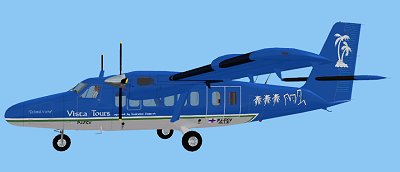
PJ-FCV
'Island Vista'
Operated by TDM for sightseeing
tours
FS9
ONLY
|
De
Havilland DHC-6 300 Vistaliner ~ Premiercraft
Canada's
most successful commercial aircraft program with more
than 800 built, the Twin Otter remains popular for its
rugged construction and useful STOL performance.
The
Series 300 was introduced from the 231st production aircraft
in 1969. It featured the lengthened nose, but also introduced
more powerful engines, thus allowing a 450kg (1000lb)
increase in takeoff weight and a 20 seat interior. Production
ceased in late 1988. In addition, six 300S enhanced STOL
performance DHC-6-300s were built in the mid 1970s.
|
|
|
Other ESSENTIAL Files:
DH6_GAU.ZIP
DH6_SND.ZIP
|
Repaint by JF
Panel ~ Included
|
|
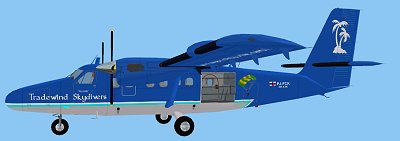
PJ-FCK
'Pegasus'
Operated by TDM for Caribbean
Skydivers
FS9
ONLY
|
De
Havilland DHC-6 300 Skydive ~ Premiercraft
Canada's
most successful commercial aircraft program with more
than 800 built, the Twin Otter remains popular for its
rugged construction and useful STOL performance.
The
Series 300 was introduced from the 231st production aircraft
in 1969. It featured the lengthened nose, but also introduced
more powerful engines, thus allowing a 450kg (1000lb)
increase in takeoff weight and a 20 seat interior. Production
ceased in late 1988. In addition, six 300S enhanced STOL
performance DHC-6-300s were built in the mid 1970s.
|
|
|
Other ESSENTIAL Files:
DH6_GAU.ZIP
DH6_SND.ZIP
|
Repaint by JF
Panel ~ Included
|

PJ-DOC 'Ducos'
FS9 - FSX
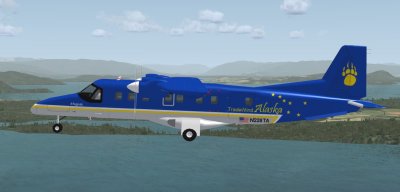
N228TA 'Afognak'
FS9 - FSX
|
Dornier Do228~ Premier Aircraft Design
The Dornier Do 228 is a small, German, twin turboprop STOL-utility aircraft manufactured by Dornier GmbH (later DASA Dornier, Fairchild-Dornier) from 1981, to 1998. In 1983, Hindustan Aeronautics bought a production licence and manufactures the 228 till this day. Approximately 270 Do 228 were built at Oberpfaffenhofen, Germany, and Kanpur, India. About 195 are still in service worldwide.
History
In the late 1970s Dornier GmbH developed a new kind of wing, the TNT ("Tragflügel neuer Technologie"), subsidized by the German government. Dornier tested it on a modified Dornier Do 28D-2 "Skyservant" and with Pratt & Whitney Canada PT6A-110 Turboprop engines. Finally Dornier changed the engine and tested the new aircraft, which was named Dornier Do 128, with two Garrett TPE 331-5 engines. The company developed a new fuselage for the TNT and TPE 331-5 in two variants (15/19 Passenger) and named both project-aircraft E-1 (later Do 228-100) and E-2 (later Do 228-200). At ILA '80 Dornier presented the new aircraft to the public. Both prototypes was flown on March 21, 1981, and May 9, 1981, for the first time. After the certification the first Do 228 entered service in the fleet of Norving Flyservice in February, 1982. Over the years Dornier offered the 228 in upgraded variants and with special equipment for special missions. In 1998, the production line was stopped for better development of the successor Dornier Do 328.
|
|
Other ESSENTIAL Files:
Base aircraft from Premier Aircraft Design
NB. Readme txt comments on mdl files
|
Repaints by Jack Ford
|
|
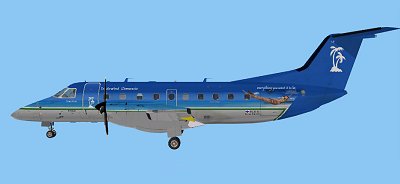
PJ-ELO
'Grand Anse'
FS9
ONLY
NB.
Base file MUST be installed first

|
Embraer
EMB-120 Brasilia ~ OSS
The
Brasilia has proved to be a popular, relatively high speed
yet comparatively inexpensive to operate and purchase
regional airliner.
Embraer
first began design work on a new regional turboprop airliner
in the late 1970s when the company studied stretching
its EMB121 Xingu corporate turboprop to a 25 seat regional
airliner. While this was the first aircraft to bear the
EMB120 designation (it was named the Araguia), the production
EMB120 is an all new aircraft. Design studies of the definitive
EMB120 began in September 1979, first flight of a PW115
powered prototype took place on July 27 1983, and entry
into service was in October 1985.
Versions
of the EMB120 include: the initial production EMB120;
the Reduced Takeoff weight EMB120RT; the Extended Range
EMB120ER; the EMB120 Cargo freighter; mixed passenger/freight
EMB120 Combi; and EMB120 Convertible. Hot and high versions
of these models have PW118A engines, which retain their
power ratings to a higher altitude.
The
current production model is the EMB120ER Advanced, which
incorporates a range of external and interior improvements.
The fuselage of the EMB120 also forms the basis for the
ERJ145 50 seat regional jet.
|
|
|
Other ESSENTIAL Files:
OSS freeware EMB-120
Optional but recommended:
aircraft.cfg update
based on real world AOM data by Karl Hajek
|
Repaint by JF
Panel ~ Included
|
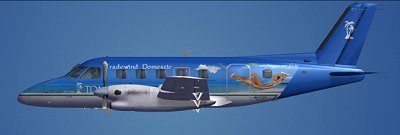
PJ-ECX 'Blue Tang' TDM
Includes
N110TA 'Brittle Star' Tradewind Alaska
For FS9 and FSX
FDE update for PAX versions ONLY
|
Embraer
EMB-110 Bandeirante ~ AEROPROYECTO
The
Embraer EMB-110 Bandeirante, or `Bandit', remains Embraer's most successful commercial aircraft program.
Design of the EMB-110 was undertaken in response to a Brazilian Ministry of Aeronautics specification for a general purpose light transport suitable for military and civilian duties. The new design was developed with the assistance of well known French designer Max Holste, and the first of three YC-95 prototypes flew for the first time on October 26 1968.
Embraer (or Empresa Brasilera de Aeronautica SA) was established the following year, and development and production of the C95 became one of the company's first responsibilities. The first production standard EMB-110 Bandeirante (Portuguese for Pioneer) flew on August 9 1972, and the first entered airline service in April 1973.
Bandeirante models include the 12 seat transport EMB-110, the aerial photography EMB-110B and maritime patrol EMB-111 for the Brazilian air force; the initial airline version, the 15 seat EMB-110C; the seven seat EMB110E executive transport; 18 seat enlarged EMB-110P; convertible passenger/freight EMB110P1 with larger rear door; the EMB-110PA which replaced the 110P as the standard passenger aircraft from 1983 and introduced dihedral to the tailplane among other minor improvements; the EMB-110P1K and EMB-110K SAR military equivalents to the P1A; the EMB-110P2 commuter with seating for up to 21; the EMB-110P2A which replaced the P2 and introduced the same changes as the P1A; and the EMB-110P1A/41 and EMBP2A/41 versions of the P1A and P2A recertificated to US FAA SFAR41 standards with higher weights.
Production of the Bandeirante ceased in May 1990, the final aircraft being delivered to the Brazilian Air Force. Today the Bandeirante's virtues of reliability and good operating economics means that it remains popular with its operators.
|
|
Other ESSENTIAL Files:
|
Repaints by JF
|
|
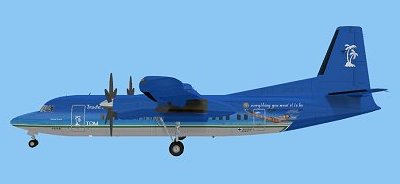
PJ-FED
'West Peak'
Includes
TL version PJ-FEK

Essential
Texture Update - Grey Spinners
or
Essential
Texture Update - Blue Spinners
or
Essential
Texture Update - Black Spinners
|
|
Fokker
50 v3 ~ Dreamwings
The
Fokker 50 was the successor to Fokker's highly successful
and long running F-27 Friendship.
Fokker announced
it was developing the 50 seat Fokker 50, together with the
100 seat jet powered Fokker 100, in November 1983. The Fokker
50 is based on the fuselage of the F-27-500 Friendship,
but incorporates a number of key design changes. Foremost
of the improvements was the new generation Pratt & Whitney
Canada PW125 turboprops driving advanced six blade props,
giving a 12% higher cruising speed and greater fuel economy,
and thus range. Other improvements include new avionics
and an EFIS glass cockpit, limited use of composites, small
`Foklet' winglets, and more, squared, main cabin windows.
Two prototypes
were built based on F-27 airframes (despite the fact that
over 80% of Fokker 50 parts are new or modified), the first
flying on December 28 1985. The first production aircraft
flew on February 13 1987, certification was granted in May
1987, and first customer delivery, to Lufthansa Cityline,
was during August that year.
The basic Fokker
50 production model is the Series 100. With three, instead
of four doors, the Series 100 is designated the Series 120.
The hot and high optimised Series 300 has more powerful
PW127B turboprops, and was announced in 1990. It has higher
cruising speeds and better field performance, particularly
at altitude.
The only significant
development of the Fokker 50 to see the light of day was
the Fokker 60 Utility, a stretched utility transport version
ordered by the Royal Netherlands Air Force. Fokker built
four for the Netherlands air force and looked at offering
a passenger variant. The Fokker 60 was stretched by 1.62m
(5ft 4in).
Fokker collapsed
due to financial problems on March 15 1996 and the last
Fokker 50 was delivered to Ethiopian Airlines in May 1997.
|
|
|
Other Suggested Files:
|
Repaint by JF
Panel ~ 2D by Espen
Øijordsbakken included
Essential to read
the docs !
|
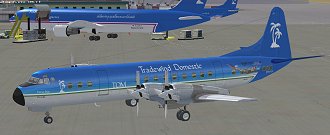
PJ-VJN
'Paria Bay'
(Also
includes N186TA
'King Cove' TA)
FSX ONLY
- texture update available
|
Lockheed L188 Electra II ~ KBT
Lockheed's Electra provided a number of airlines with their introduction to turbine powered aircraft. Today it remains popular with freight operators.
The Lockheed L-188 Electra was developed to meet a 1954 American Airlines requirement for a domestic short to medium range 75 to 100 seat airliner. In June 1955 American awarded Lockheed an order for 35 such aircraft. Lockheed's design, the L-188, was a low wing, four turboprop powered aircraft. Many other airlines shared American's interest in the L-188, and by the time the first prototype flew on December 6 1957, the order book stood at 144. Service entry was with Eastern Airlines (due to a pilot's strike at American) on January 12 1959.
However, any optimism Lockheed felt about a strong sales future would have been short lived, as a number of crashes in 1959 and 1960 (two of which where the aircraft broke up in flight) contributed to a number of order cancellations.
As an interim measure following the crashes, speed restrictions were imposed on Electras. Investigations uncovered a design defect with the engine mountings where the wing would shake and eventually break up. Lockheed undertook a significant modification program where the nacelles, nacelle mountings and wing structure were strengthened, and the speed restrictions were eventually lifted in 1961. After that the Electra proved reliable and popular in service, but the damage had been done and production wound up in 1961 after 170 had been built.
Lockheed built two basic versions of the Electra. The L-188A was the basic production aircraft, and accounted for most Electra sales. The L-188C entered service with KLM in 1959 and had greater fuel capacity and higher weights, and thus improved payload range performance.
The Electra also forms the basis for the hugely successful P-3 Orion long range maritime surveillance aircraft of which more than 600 have been built.
Most Electras currently in service are configured as freighters. From 1967 Lockheed converted 41 Electras to freighters or convertible freighter/passenger aircraft, fitting a strengthened floor and a large cargo door forward of the wing on the left side. Other companies have also converted Electras to freighters. However, a small number remain in passenger service.
|
|
Other ESSENTIAL Files:
|
Repaint by Francisco
Aguiar
Panel ~ Included
Must read the docs
!
|
|
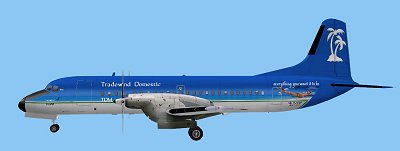
PJ-YSP
'Hispaniola'
(Also
includes PJ-YSC, PJ-YSF TL Cargo
and N116TA
TA Combi)
52Mb
|
NAMC
YS-11 ~ AFG
The
only Japanese airliner to enter production since WW2,
the YS11 achieved a degree of success in its domestic
market and in North America.
The
YS11 was a product of the Nihon Aircraft Manufacturing
Company (or NAMC), a consortium of Fuji, Kawasaki, Mitsubishi,
Nippi, Shin Meiwa (now Shin Maywa) and Showa. NAMC formed
on June 1 1959 to design and develop a short to medium
range airliner, with particular attention being paid to
meeting the specific operating requirements of the Japanese
domestic airlines.
NAMC
selected the RollsRoyce Dart over the Allison 501 to power
the new airliner. Fuji was given responsibility for the
tail unit, Kawasaki the wings and engine nacelles, Mitsubishi
the forward fuselage and final assembly, Nippi the ailerons
and flaps, Shin Meiwa the rear fuselage and Showa the
light alloy honeycomb structural components.
The
YS11 first flew on August 30 1962 (a second prototype
flew that December), and was awarded Japanese certification
in August 1964. By that time the first production aircraft
were under construction, and the type entered service
with Toa Airways (now JAS) in April 1965. Initial production
was of the YS11100, the follow up YS11A200 (first flight
November 1967) was designed for export markets and featured
an increased max takeoff weight. The YS11A300 was a combi
passenger/freight model, while the YS11A400 was a pure
freighter with a forward freight door.
The
YS11A500, 600 and 700 were equivalent to the 200, 300
and 400, but with a 500kg (1100lb) greater max takeoff
weight. Production ceased in February 1974.
By
late 1998 66 YS11s remained in commercial service. The
largest operators were All Nippon (6) and Japan Air Commuter
(12).
|
|
|
Other ESSENTIAL Files:
|
Repaint by JF
Panel ~ Included
Must read the docs
!
|
|
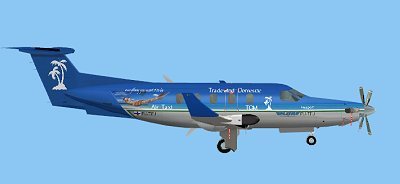
PJ-FTJ
'Freeport'
(Textures only)
Operated by TDM Air Taxi
|
Pilatus
PC-12 ~ AFG
The
PC-12 is a King Air class and size turboprop aimed at
corporate transport and regional airliner operators. It
is the latest in a line of single engined PT6 powered
Pilatus products.
Pilatus
announced it was developing the PC-12 at the National
Business Aircraft Association's annual convention in October
1989. First flight of the first of two prototypes occurred
on May 31 1991. Certification was originally planned for
mid 1993 but a redesign of the wings with the addition
of winglets to ensure performance guarantees were met
pushed this back, with Swiss certification awarded on
March 30 1994 and US FAA FAR Part 23 approval following
on July 15 1994.
Compared
to the King Air 200 twin, its major competitor, the PC-12's
most significant design feature is its use of a single
PT6A-67B turboshaft. Internally the PC-12's cabin is also
longer (by 6cm/2.4in) and wider (by 15cm/6in) than the
King Air 200's, and the same height. The cockpit features
EFIS displays and the PC-12 is certificated for single
pilot operation while each PC-12 built features a standard
cargo door in the rear fuselage. Weather radar is an option
but has been fitted to all production aircraft thus far.
From 1997 the increased 4.5 tonne MTOW has been standard.
New, smaller winglets were introduced in 1998.
The
PC-12 is offered in standard nine seat airliner form,
in a four passenger seat/freight combi version and as
a six place corporate transport. A pure freighter model
is under consideration. The PC-12 Eagle is a military
special missions platform.
Most
PC-12s built thus far have been corporate transports but
recent important regulatory changes in Australia, Brazil,
Canada and the USA have cleared single engine turboprops
for IFR RPT operations in those nations. This has opened
up new potential markets for the PC12 as a regional airliner,
replacing older King Airs and elderly piston twins such
as the Navajo Chieftain and Cessna 400 series.
|
|
|
Other Essential Files:
AFG
PC12 for FS9
Other Optional Files:
FS2002
Mod
Improved
Sound
|
Repaint by Pat Hanna
Panel ~ Included (NB:
Read Notes)
|
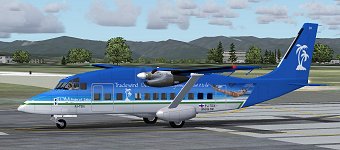
PJ-TDX 'Pride of Saba'
Includes N360TA 'Qawalangin'
FS9 - FSX
|
Shorts 360 ~ Premier Aircraft Design
The Short 360 is a stretched, larger capacity and improved 36 seat derivative of the 30 seat Short 330.
The relative success of the rugged Short 330 prompted the Northern Ireland based manufacturer to study and subsequently develop a stretched derivative. Short announced it was developing the new airliner in mid 1980, and a prototype 360 flew for the first time almost a year later on June 1 1981.
The first production 360 flew in August 1982 and certification was awarded on September 3 that year. The 360 entered service with Suburban Airlines in the US in November 1982.
The two Short airliners are very close in overall dimensions and size, but the later 360 is easily identified by its new conventional tail unit mounted on a revised rear fuselage. The 360 is also 91cm (3ft) longer than the 330, allowing two more seat rows and six extra passengers to be carried, while the extra length reduces drag. Power is supplied by two Pratt & Whitney PT6A65Rs, and the 360's wing span is slightly greater. Otherwise the 330 and 360 are very similar, and share a high degree of commonality.
Short marketed a number of 360 developments, the first of which was the 360 Advanced with 1062kW (1424shp) PT6A65ARs. The 360 Advanced was introduced in late 1985, but was soon followed by the further improved 360300, which entered service in March 1987. The 360300 introduced advanced six blade propellers, more powerful PT6A67R engines giving a higher cruise speed and improved hot and high performance, plus other aerodynamic improvements. The 360300 was also built in 360300F freighter form.
|
|
Other ESSENTIAL Files:
Base aircraft from Premier Aircraft Design
NB. Readme txt comments on mdl files
|
Repaints by Jack Ford
|
|






















